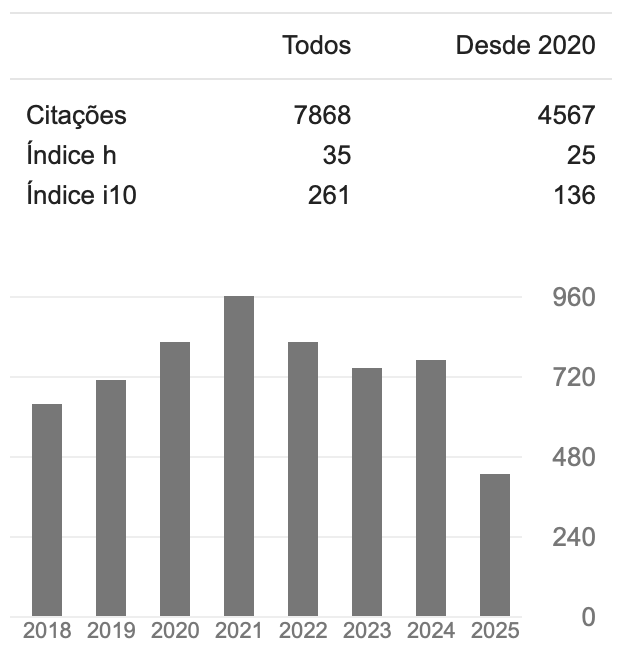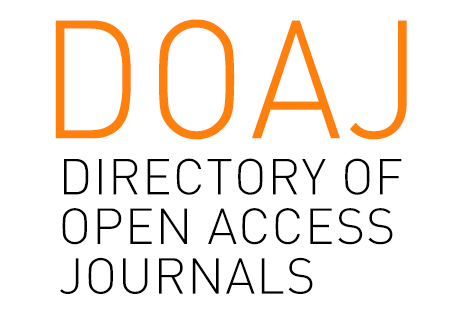Alterações na cinemática da marcha hemiparética: um estudo comparativo
DOI:
https://doi.org/10.17765/2176-9206.2022v15n2.e10447Palavras-chave:
Acidente vascular encefálico, Hemiparesia, MarchaResumo
O objetivo principal deste estudo foi analisar as alterações da marcha de adultos com hemiparesia após acidente vascular encefálico (AVE) e comparar com sujeitos saudáveis. A amostra foi composta por 14 participantes do grupo AVE e 14 participantes pareados do grupo-controle (CON). Foi realizada uma análise tridimensional da marcha mediante um sistema de cinemetria. Os parâmetros analisados foram a velocidade, o comprimento da passada, a largura da passada, a cadência e o tempo da passada, sendo utilizado o teste t independente para as comparações entre os grupos e considerando p < 0,05 como critério de decisão. Os participantes do grupo AVE apresentaram valores médios significantemente inferiores em todos os parâmetros analisados. Além disso, os pacientes do grupo AVE também tiveram valores muito inferiores quando comparados aos de outros estudos com pacientes pós-AVE, possivelmente devido ao curto período entre o AVE (média de 14,14 meses) e a avaliação da marcha.Downloads
Referências
1. Bensenor IM, Goulart AC, Szwarcwald CL, Vieira ML, Malta DC, Lotufo PA. Prevalence of stroke and associated disability in Brazil: National Health Survey- 2013. Arq Neuropsiquiatr. 2015; 73(1): 746-50.
2. Naghavi M, Marczak LB, Kutz M, Shackelford KA, Arora M, Miller-Petrie M, et al. Global mortality from firearms, 1990-2016. Jama. 2018; 320(8):792-814.
3. GBD 2016 Stroke Collaborators. Global, regional, and national burden of stroke, 1990-2016: a systematic analysis for the Global Burden of Disease Study 2016. Lancet Neurol. 2019; 18:439-58.
4. Benjamin EJ, Virani SS, Callaway CW, Chamberlain AM, Chang AR, Cheng S, et al. Heart disease and stroke statistics-2018 update: a report from the American Heart Association. Circulation. 2018; 137(12):e67-e492.
5. Belda-Lois JM, Mena-del Horno S, Bermejo-Bosch I, Moreno JC, Pons JL, Farina D, et al. Rehabilitation of gait after stroke: a review towards a top-down approach. J. NeuroEng. Rehabil. 2011; 8(1):1-20.
6. Jung JH, Lee SW. Immediate effects of single-leg stance exercise on dynamic balance, weight bearing and gait cycle in stroke patients. Phys Ther Rehabil Sci. 2014; 3(1):49-54.
7. Dierick F, Dehas M, Isambert JL, Injeyan S, Bouche AF, Bleyenheuft Y, et al. Hemorrhagic versus ischemic stroke: Who can best benefit from blended conventional physiotherapy with robotic-assisted gait therapy? PLoS One. 2017; 12(6):e0178636.
8. Andrenelli E, Ippoliti E, Coccia M, Millevolte M, Cicconi B, Latini L, et al. Features and predictors of activity limitations and participation restriction 2 years after intensive rehabilitation following first-ever stroke. Eur J Phys Rehabil Med. 2015; 51(1):575-85.
9. Maranesi E, Riccardi GR, Di Donna V, Di Rosa M, Fabbietti P, Luzi R, et al. Effectiveness of intervention based on end-effector gait trainer in older patients with stroke: A systematic review. J Am Med Dir Assoc. 2020; 21(8):1036-44.
10. Stanhope VA, Knarr BA, Reisman DS, Higginson JS. Frontal plane compensatory strategies associated with self-selected walking speed in individuals post-stroke. Clin Biomech. 2014; 29(5):518-22.
11. Sheffler LR, Chae J. Hemiparetic gait. Phys Med Rehabil Clin N Am. 2015; 26(4):611-23.
12. Lee HH, Jung SH. Prediction of post-stroke falls by quantitative assessment of balance. Ann Rehabil Med. 2017; 41(3):339-46.
13. Tisserand R, Armand S, Allali G, Schnider A, Baillieul S. Cognitive-motor dual-task interference modulates mediolateral dynamic stability during gait in post-stroke individuals. Hum Mov Sci. 2018; 58(1):175-84.
14. Mansfield A, Wong JS, McIlroy WE, Biasin L, Brunton K, Bayley M. Do measures of reactive balance control predict falls in people with stroke returning to the community? Physiotherapy. 2015; 101(4):373-80.
15. Brown AW, Lee M, Lennon RJ, Niewczyk PM. Functional performance and discharge setting predict outcomes 3 months after rehabilitation hospitalization for stroke. J Stroke Cerebrovasc Dis. 2020; 29(5):104746.
16. Winstein CJ, Stein J, Arena R, Bates B, Cherney LR, Cramer SC, et al. Guidelines for adult stroke rehabilitation and recovery: a guideline for healthcare professionals from the American Heart Association/American Stroke Association. Stroke. 2016; 47(6):e98-e169.
17. Sánchez N, Finley J. Individual differences in locomotor function predict the capacity to reduce asymmetry and modify the energetic cost of walking poststroke. Neurorehabil Neural Repair. 2018; 32(8):701-13.
18. Belgen B, Beninato M, Sullivan PE, Narielwalla K. The association of balance capacity and falls self-efficacy with history of falling in community-dwelling people with chronic stroke. Arch Phys Med Rehabil. 2006; 87(4):554-61.
19. Punt M, Bruijn SM, van Schooten KS, Pijnappels M, van de Port IG, Wittink H, et al. Characteristics of daily life gait in fall and non fall-prone stroke survivors and controls. J Neuroeng Rehabil. 2016; 13(1):1-7.
20. Fotiadou S, Aggeloussis N, Gourgoulis V, Malliou P, Papanas N, Giannakou E, et al. Reproducibility of gait kinematics and kinetics in chronic stroke patients. NeuroRehabilitation. 2018; 42(1):53-61.
21. Geiger M, Supiot A, Pradon D, Do MC, Zory R, Roche N. Minimal detectable change of kinematic and spatiotemporal parameters in patients with chronic stroke across three sessions of gait analysis. Human Mov Sci. 2019; 64(1):101-7.
22. Laroche D, Duval A, Morisset C, Beis JN, D’athis P, Maillefert JF, et al. Test-retest reliability of 3D kinematic gait variables in hip osteoarthritis patients. Osteoart Cart. 2011; 19(2):194-9.
23. Callegari-Jacques SM. Bioestatística: princípios e aplicações. Porto Alegre: Artmed; 2003.
24. Pollock A, St George B, Fenton M, Firkins L. Top 10 research priorities relating to life after stroke--consensus from stroke survivors, caregivers, and health professionals. Int J Stroke. 2014; 9(3):313-20.
25. Molteni F, Gasperini G, Cannaviello G, Guanziroli E. Exoskeleton and end-effector for upper and lower limbs rehabilitation: Narrative review. PM&R. 2018; 10(9):S174-88.
26. Hioka A, Tada Y, Kitazato K, Akazawa N, Takagi Y, Nagahiro S. Action observation treatment improves gait ability in subacute to convalescent stroke patients. J Clin Neurosci. 2020; 75(1):55-61.
27. Wonsetler EC, Bowden MG. A systematic review of mechanisms of gait speed change post-stroke. Part 1: spatiotemporal parameters and asymmetry ratios. Top Stroke Rehabil. 2017; 24(6):435-46.
28. Wren TA, Tucker CA, Rethlefsen SA, Gorton III GE, Õunpuu S. Clinical efficacy of instrumented gait analysis: Systematic review 2020 update. Gait Posture. 2020; 80(1):274-9.
29. Kao PC, Dingwell JB, Higginson JS, Binder-Macleod S. Dynamic instability during post-stroke hemiparetic walking. Gait Posture. 2014; 40(3):457-63.
30. Gama GL, Celestino ML, Barela JA, Barela AM. Gait initiation and partial body weight unloading for functional improvement in post-stroke individuals. Gait Posture. 2019; 68(1):305-10.
31. Schinkel-Ivy A, Wong JS, Mansfield A. Balance confidence is related to features of balance and gait in individuals with chronic stroke. J Stroke Cerebrovasc Dis. 2017; 26(2):237-45.
32. Bowden MG, Balasubramanian CK, Behrman AL, Kautz SA. Validation of a speed-based classification system using quantitative measures of walking performance poststroke. Neurorehabil Neural Repair. 2008; 22(6):672-5.
33. Hak L, Houdijk H, van der Wurff P, Prins MR, Beek MJ, van Dieen JH. Stride frequency and length adjustment in post-stroke individuals: influence on the margins of stability. J Rehabil Med. 2015; 47(2):126-32.
34. Wonsetler, EC, Bowden MG. A systematic review of mechanisms of gait speed change post-stroke. Part 2: exercise capacity, muscle activation, kinetics, and kinematics. Top Stroke Rehabil. 2017; 24(5):394-403.
35. Fulk GD, He Y, Boyne P, Dunning K. Predicting home and community walking activity poststroke. Stroke. 2017; 48(2):406-11.
36. Boudarham J, Roche N, Pradon D, Bonnyaud C, Bensmail D, Zory R. Variations in kinematics during clinical gait analysis in stroke patients. PloS One. 2013; 8(6):e66421.
37. Curuk E, Goyal N, Aruin AS. The effect of motor and cognitive tasks on gait in people with stroke. J Stroke Cerebrovasc Dis. 2019; 28(11):104330.
38. Wang Y, Mukaino M, Ohtsuka K, Otaka Y, Tanikawa H, Matsuda F, et al. Gait characteristics of post-stroke hemiparetic patients with different walking speeds. International journal of rehabilitation research. Int J Rehabil Res. 2020; 43(1):69-75.
39. Hendrickson J, Patterson KK, Inness EL, McIlroy WE, Mansfield A. Relationship between asymmetry of quiet standing balance control and walking post-stroke. Gait Posture 2014; 39(1):177-81.
40. Vachranukunkiet T, Esquenazi A. Pathophysiology of gait disturbance in neurologic disorders and clinical presentations. Phys Med Rehabil Clin N Am. 2013; 24(2):233-46.
41. Balaban B, Tok F. Gait disturbances in patients with stroke. PM&R. 2014; 6(7):635-42.
42. Doi T, Nakakubo S, Tsutsumimoto K, Kurita S, Ishii H, Shimada H. Spatiotemporal gait characteristics and risk of mortality in community-dwelling older adults. Maturitas. 2021; 151(1):31-5.
43. Verma R, Arya KN, Sharma P, Garg RK. Understanding gait control in post-stroke: implications for management. J Bodyw Mov Ther. 2012; 16(1):14-21.
44. Beyaert C, Vasa R, Frykberg GE. Gait post-stroke: Pathophysiology and rehabilitation strategies. Neurophysiol Clin. 2015; 45(4-5):335-55.
Arquivos adicionais
Publicado
Como Citar
Edição
Seção
Licença
A submissão de originais para a revista Saúde e Pesquisa implica na transferência da Carta Concessão de Direitos Autorais, pelos autores, dos direitos de publicação digital para a revista após serem informados do aceite de publicação.A Secretaria Editorial irá fornecer da um modelo de Carta de Concessão de Direitos Autorais, indicando o cumprimento integral de princípios éticos e legislação específica. Os direitos autorais dos artigos publicados nesta revista são de direito do autor, com direitos da revista sobre a primeira publicação. Os autores somente poderão utilizar os mesmos resultados em outras publicações, indicando claramente a revista Saúde e Pesquisa como o meio da publicação original. Em virtude de tratar-se de um periódico de acesso aberto, é permitido o uso gratuito dos artigos, principalmente em aplicações educacionais e científicas, desde que citada a fonte. A Saúde e Pesquisa adota a licença Creative Commons Attribution 4.0 International.
A revista se reserva o direito de efetuar, nos originais, alterações de ordem normativa, ortográfica e gramatical, com vistas a manter o padrão culto da língua e a credibilidade do veículo. Respeitará, no entanto, o estilo de escrever dos autores. Alterações, correções ou sugestões de ordem conceitual serão encaminhadas aos autores, quando necessário. Nesses casos, os artigos, depois de adequados, deverão ser submetidos a nova apreciação. As opiniões emitidas pelos autores dos artigos são de sua exclusiva responsabilidade.


















